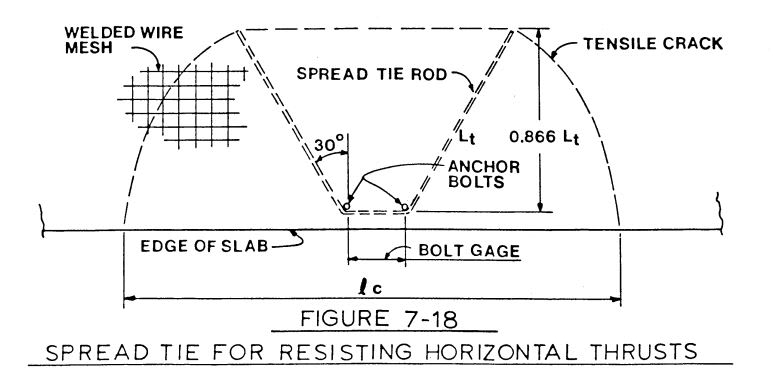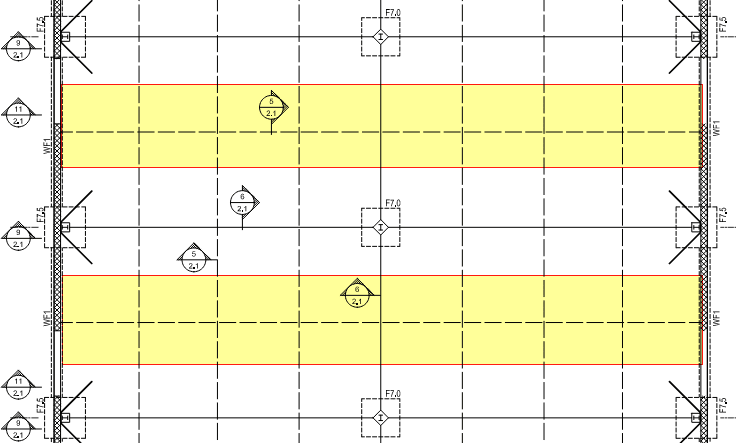Navigation
Install the app
How to install the app on iOS
Follow along with the video below to see how to install our site as a web app on your home screen.
Note: This feature may not be available in some browsers.
More options
Style variation
-
Congratulations TugboatEng on being selected by the Eng-Tips community for having the most helpful posts in the forums last week. Way to Go!
You are using an out of date browser. It may not display this or other websites correctly.
You should upgrade or use an alternative browser.
You should upgrade or use an alternative browser.
PEMB Foundation design with hairpins 4
- Thread starter Ben29
- Start date
- Status
- Not open for further replies.
DoubleStud
Structural
If you have more area of steel than the 2 hairpin in that region would say yes?
jerseyshore
Structural
As long as you are outside of the tensile crack zone, sure.


Jersey, you consider all your resistance to the lateral load to be within that zone?
I`d typically argue that the hairpins transfer the load to the slab reinforcing (mesh in your snip), and the important area is much larger than your sketch shows.
I`d typically argue that the hairpins transfer the load to the slab reinforcing (mesh in your snip), and the important area is much larger than your sketch shows.
jerseyshore
Structural
Yes the mesh or reinf is essential to the design of hairpins. Sorry I didn't realize OP was talking about physically leaving sections of the slab open. Was thinking more about joints. Not sure why you'd only pour half a slab. If you are going to leave strips of concrete slab in place it's probably better to just design straight tie rods.
I've done a bunch of these, and a lot of it comes down to the function of the slab. If you have wire mesh, you're likely designing a slab on grade with control joints. Typical practice is to discontinue or cut every other wire across those joints to allow the slab to crack properly. Based on the aspect ratio of your slab joints, do you have enough concrete to resolve the thrust into the slab, and drag it out via gravity/friction?
If you have a heavy industrial slab that functions as a structural slab or mat foundation, chances are you might have deformed bars to which you may be able to quantify a much larger chunk of concrete.
If you have a heavy industrial slab that functions as a structural slab or mat foundation, chances are you might have deformed bars to which you may be able to quantify a much larger chunk of concrete.
I would be really cautions about this approach and heavily disclaim that slabs are not to be cut.jerseyshore said:If you are going to leave strips of concrete slab in place it's probably better to just design straight tie rods.
-
1
- #9
jerseyshore
Structural
I've never used or seen anything other than hairpins designed to resist the thrust on PEMB's, even moderately sized ones. Sometimes the lengths are long and slabs/ reinf get thick, but it's definitely the preferred method around here.
One of my clients decided to replace a slab recently (I got involved after the fact) When I first went on site, I observed hairpin bars sticking out in the air in a mangled mess or cut off at the foundation. It had never even crossed his mind that the building’s stability would be relying on that slab.
Hairpins with slab bars is absolutely a candidate.
This is an interesting thought exercise, but how much benefit to the owner is it? I suppose you could run some deep sanitary mains that you could tie into when needed, but these narrow zones do not leave much space for anything other than a washroom or two. If this is a CRU, I would argue it is probable future mech trades will cut through this without hesitation. We normally are supporting frames on piles, so I usually design the piles for the thrust force. We did one PEB in 1996 where they would not spend the extra on the piles, so we had ties from side to side. That project was never completed, and the building has been sold two times since then. The first owner cut many of the ties, and the new owners are hillbillies that have cut them even more. Maybe your TI process is better defined in your area, but if not, I am not sure how much time I would fret about this.
I have used hairpins. You just need to activate the right amount of slab. They are cheap and PEMBs are all about cheap. Future problems in PEMBs are for future owners. You don't beef up the roof just in case they need to one day hang proces pipe, do you? Generally, no. Cheap and flimsy and the code allows. And then a little more.
I'm not a fan in a process building where the facility needs will likely change in the life of the building, but these are discussions you can have with the owner/developer.
I'm not a fan in a process building where the facility needs will likely change in the life of the building, but these are discussions you can have with the owner/developer.
-
1
- #17
I put slab hairpins in the same category as gypsum shear walls and metal roofing/siding diaphragms. They work on paper but the reliability in the real world is lower than I am comfortable with. That's probably why they have niches in competitive commodity industries.
couldn't have put it better myself, bones.
StrEng007 - I agree, they are an option. I just don't find them to be a very good one. But they time you account for the angle, lapping the bars, reinforcing the slab as a structural element (something not often done as they just use 1.4 or 2.0 WWR to limit crack widths), I found that it uses way more steel than just running 4 tension bars straight across the building below the slab. That way, you have a 12x12 tension tie and the rest of the slab can be left out for pluming rough ins by future tenants.
StrEng007 - I agree, they are an option. I just don't find them to be a very good one. But they time you account for the angle, lapping the bars, reinforcing the slab as a structural element (something not often done as they just use 1.4 or 2.0 WWR to limit crack widths), I found that it uses way more steel than just running 4 tension bars straight across the building below the slab. That way, you have a 12x12 tension tie and the rest of the slab can be left out for pluming rough ins by future tenants.
DoubleStud
Structural
Did people put hair pins prior the Appendix D/Chapter 17 update? It seems the Appendix D came out but metal building standard remains the same (bolts very close together only inches away from edge of building).
- Status
- Not open for further replies.
Similar threads
- Replies
- 14
- Views
- 1K
- Locked
- Question
- Replies
- 3
- Views
- 5K
- Locked
- Question
- Replies
- 31
- Views
- 2K
- Replies
- 7
- Views
- 15K
- Replies
- 8
- Views
- 5K

